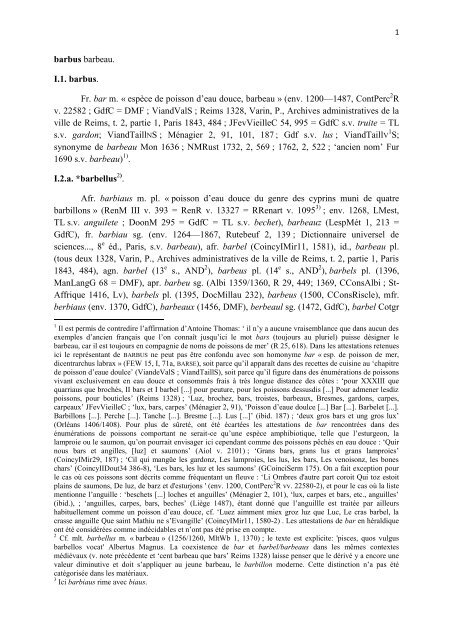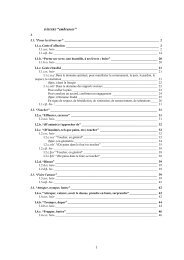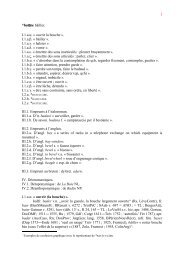barbus barbeau. I.1. barbus. Fr. bar m. « espèce de poisson d'eau ...
barbus barbeau. I.1. barbus. Fr. bar m. « espèce de poisson d'eau ...
barbus barbeau. I.1. barbus. Fr. bar m. « espèce de poisson d'eau ...
Create successful ePaper yourself
Turn your PDF publications into a flip-book with our unique Google optimized e-Paper software.
21611, mfr. frm. <strong><strong>bar</strong>beau</strong> 4 (dp. Est 1549), Malm. <strong>bar</strong>bê <strong>«</strong> <strong><strong>bar</strong>beau</strong>, <strong>poisson</strong> d’eau douce »Scius, liég. Bast. id., Bouillon b a r b , pic. <strong>bar</strong>bieu Daire, Civray <strong>bar</strong>bio Mauduyt, St-Seurin<strong>bar</strong>bia, bourg. bairbeau, bairbiâ, <strong>bar</strong>biau (tous trois Dur), Monthermé b a r b y a, b a r b y ,Chiny, Florenv. b a r b , Cum. <strong><strong>bar</strong>beau</strong>, gaum. <strong>bar</strong>bé <strong>«</strong> <strong><strong>bar</strong>bus</strong> fluviatilis Ag. », Chassepierre<strong>bar</strong>bé <strong>«</strong> <strong><strong>bar</strong>beau</strong> », St-Léger <strong>bar</strong>bîè, HSaône b a r b ALFC p 49, b rb ALFC p 46,Châten. b rb, Doubs id. ALFC p 23, b a r b ALFC p 61, b rb ALFC p 14, Montbél.bairbai D, bairbé, Ajoie bairbé, b rb, <strong>Fr</strong>Mont. id., Moutier b rb, Lac b rb( l ) y ,GrosV. b a r b , HSav. <strong>bar</strong>biau, Sav. b a r b DuraffGloss 1055, Albanais <strong>bar</strong>byô, Ainb a r b w , b a r b y (tous <strong>de</strong>ux DuraffGloss 1055), Vaux id., hdauph. b a r b y , occit.<strong>bar</strong>bèu M, bdauph. id., daupha. <strong>bar</strong>bel, Nice <strong>bar</strong>bèu, mars. <strong>bar</strong>beou A, Aix id. P, lang. <strong>bar</strong>bèlM, <strong>bar</strong>bèu (17 e s., M s.v. <strong>bar</strong>but), <strong>bar</strong>beou Honnorat, Alès <strong>bar</strong>bèl, St-Hipp. <strong>bar</strong>beou (1798),Carc. <strong>bar</strong>beù, Rivel <strong>bar</strong>bèu, Foix <strong>bar</strong>bèl, Massat <strong>bar</strong>bèu, Toulouse <strong>bar</strong>bèau G, <strong>bar</strong>bèl (rég.),Tarn <strong>bar</strong>bèou, castr. <strong>bar</strong>beou, aveyr. borbèou, <strong>bar</strong>bèou, VillefrR. <strong>bar</strong>bèu, Lozère id., <strong>bar</strong>bèl(tous <strong>de</strong>ux EscGab), b a r b l <strong>«</strong> goujon » CampAtlas 542, Ste-En. St-GermC. Bleym.<strong>«</strong> <strong><strong>bar</strong>beau</strong> », St-MartinA. b a r b w MélRostaing 734, Vans, LLouvesc <strong>bar</strong>bèl, Pra<strong>de</strong>llesb a r b y, Ytrac b o r b w, PuyD. <strong>bar</strong>bê <strong>«</strong> id. ; <strong>bar</strong>billon ; loche » Reichel, Vinz. b å r b ,Lastic b a r b M 60, Chav. borbéôou, hlim. <strong>bar</strong>bēū Dhér, périg. <strong>bar</strong>bèu, Sarlat <strong>bar</strong>bel,Agenais <strong>bar</strong>beou, Lomagne <strong>bar</strong>beou DATh 5) , Gers id., St-Gau<strong>de</strong>ns <strong>bar</strong>bèou, béarn. <strong>bar</strong>bèu,land. <strong>bar</strong>beou, landm. <strong>bar</strong>be-haut PalaySuppl, Teste <strong>bar</strong>behaout (> <strong><strong>bar</strong>beau</strong> M). RlFn 3, 147-8 ; Brun 2, 173 ; ALFC CXXXI. V. aussi ALLOr 458 ; ALLOc 360 ; ALMC 384 ; ALAL574.Locutions nominales : <strong>Fr</strong>m. <strong><strong>bar</strong>beau</strong> plébéien m. <strong>«</strong> <strong>espèce</strong> <strong>de</strong> <strong><strong>bar</strong>beau</strong> italien, <strong><strong>bar</strong>bus</strong>plebeius » (dp. 1842, Cuvier, Histoire naturelle <strong>de</strong>s <strong>poisson</strong>s ; Paris, t. 16, 139) 6) ; <strong><strong>bar</strong>beau</strong>méridional <strong>«</strong> <strong>poisson</strong> semblable au <strong><strong>bar</strong>beau</strong> commun avec la différence que la nageoiredorsale n’a pas <strong>de</strong> rayon <strong>de</strong>ntelé » (dp. 1866, Blanchard, E., Les <strong>poisson</strong>s <strong>de</strong>s eaux douces <strong>de</strong>la <strong>Fr</strong>ance ; Paris, 313) ; <strong><strong>bar</strong>beau</strong> canin <strong>«</strong> <strong>poisson</strong> ressemblant au <strong><strong>bar</strong>beau</strong> méridional, répanduen Italie » (dp. 1842, Cuvier, Histoire naturelle <strong>de</strong>s <strong>poisson</strong>s ; Paris, t. 16, 142) 7) ; Hér.b a r β tr t á t <strong>«</strong> <strong><strong>bar</strong>beau</strong> méridional » ALLOc 458 p 34.01, Au<strong>de</strong> b a r β tr i t á t ibid., b a r β t r œ t á t ibid. p 11.12, Carc. <strong>bar</strong>beù truitat ; Hér. b a r β 4 Pour <strong>de</strong>s équivalents français <strong>de</strong>s noms scientifiques latins i<strong>de</strong>ntifiant les différentes <strong>espèce</strong>s répertoriées au 19 es. voir Cuvier/Valenciennes, Histoire naturelle <strong>de</strong>s <strong>poisson</strong>s, t. 16, Paris, 1842, pp. 122-205.5 Les formes gasconnes sont <strong>de</strong>s adaptations du français, cf. Comminges b a r β w, BecInterférences 96.6 Cf. it. <strong>bar</strong>bo plebeo (1906, LEI 4, 1319, BARBUS).7 Cf. it. <strong>bar</strong>bo canino (1906, LEI 4, 1319, BARBUS).
4[+ -] Occit. <strong>bar</strong>belaio f. <strong>«</strong> les jeunes garçons » (Hér. 19 e s., M ; > Pauli 348).[+ -] Occit. <strong>bar</strong>beliero f. <strong>«</strong> nasse dont on se sert pour pêcher les <strong><strong>bar</strong>beau</strong>x » M.[+ -] Aveyr. borbeládo f. <strong>«</strong> ban<strong>de</strong>, troupe <strong>de</strong> <strong><strong>bar</strong>beau</strong>x » (> <strong>bar</strong>belado M).[+ -] HGar. b a r b lát m. <strong>«</strong> <strong><strong>bar</strong>beau</strong> » ALLOc 360 p 31.33, Toulouse <strong>bar</strong>belat (rég.).[+ -] <strong>Fr</strong>m. <strong>bar</strong>blau m. <strong>«</strong> <strong><strong>bar</strong>beau</strong> » (1738—Li, Artedi, P., Descriptiones specierumpiscium, Ichthyologiae pars V, Lugduni Batavorum, 9), Lux. <strong>bar</strong>beleau <strong>«</strong> jeune <strong><strong>bar</strong>beau</strong> »RlFn 3, 148.[+ -] Landm. <strong>bar</strong>behalin m. <strong>«</strong> petit <strong><strong>bar</strong>beau</strong> » PalaySuppl, Teste id. (> <strong>bar</strong>bealin M). [+ -] Arès <strong>bar</strong>bahalinèir m. <strong>«</strong> pêcheur <strong>de</strong> rougets ».[+ -] Afr. mfr. <strong>bar</strong>belet m. <strong>«</strong> petit <strong><strong>bar</strong>beau</strong> » (fin 13 e s.—16 e s., JubNRec 2, 259 = TL ;Ménagier 2, 187 ; 1400, DMF ; GdfC), occit. id. M.[+ -] Aveyr. borbelóu m. <strong>«</strong> <strong>bar</strong>billon, petit <strong><strong>bar</strong>beau</strong> », lim. <strong>bar</strong>belou <strong>«</strong> petit <strong><strong>bar</strong>beau</strong> » M.[+ -] Gaum. <strong>bar</strong>belot m. <strong>«</strong> jeune <strong><strong>bar</strong>beau</strong> » BSLW 41, 114.I.2.b. Changement <strong>de</strong> suffixe.[+ -illon] <strong>Fr</strong>. <strong>bar</strong>billon m. <strong>«</strong> petit <strong><strong>bar</strong>beau</strong> » (fin 13 e s.—15 e s., ViandValS ; ViandTaillS ;Ménagier, DMF ; dp. Est 1549), mfr. <strong>bar</strong>boillon (1371, Gdf ; TL), <strong>bar</strong>bion (1805, Courscomplet d’agriculture... ; Paris, t. 11, s.v. <strong><strong>bar</strong>beau</strong> ; Li), liég. <strong>bar</strong>biyon <strong>«</strong> <strong>bar</strong>billon », Nam.nam. <strong>«</strong> petit <strong><strong>bar</strong>beau</strong> », Giv. Fumay b a r b i y <strong>«</strong> <strong><strong>bar</strong>beau</strong> », Sarthe <strong>bar</strong>billon, Civray <strong>«</strong> jeune<strong><strong>bar</strong>beau</strong> », centr. <strong>«</strong> <strong><strong>bar</strong>beau</strong> », bberr. <strong>«</strong> sorte <strong>de</strong> <strong>poisson</strong> (et non petit <strong><strong>bar</strong>beau</strong>) », Metz, Isle,Paysh. b r b y <strong>«</strong> petit <strong><strong>bar</strong>beau</strong> », Chassepierre <strong>bar</strong>byon, BroyeP. b a r b i y , Ponc.<strong>«</strong> <strong><strong>bar</strong>beau</strong> », occit. <strong>bar</strong>bihoun <strong>«</strong> <strong>bar</strong>billon » M, Lozère <strong>bar</strong>bilhou <strong>«</strong> petit <strong><strong>bar</strong>beau</strong> » EscGab,Aveyr. b a r β i <strong>«</strong> <strong><strong>bar</strong>beau</strong> » ALLOc 360 p 12.20, Maringues b a r b i y ALAL 574,Creuse b a r b i y ibid. p 22, b a r b i y (ibid. p 34, 35), HVienne b a r b i y ibid. p 65,hlim. <strong>bar</strong>biliou Dhér, béarn. <strong>bar</strong>bilhoû <strong>«</strong> <strong>bar</strong>billon ». [× -] Hér. b a r β i y á t m. <strong>«</strong> jeune<strong><strong>bar</strong>beau</strong> » ALLOr 458 p 34.06, Carc. <strong>bar</strong>billat <strong>«</strong> petit <strong><strong>bar</strong>beau</strong> », castr. <strong>bar</strong>bilhat <strong>«</strong> <strong>bar</strong>billon,sorte <strong>de</strong> petit <strong>poisson</strong> » (> <strong>bar</strong>bihat M), Camarès borbillát <strong>«</strong> <strong><strong>bar</strong>beau</strong> <strong>de</strong> petite <strong>espèce</strong> ».
5Locutions nominales : Argot <strong>bar</strong>billons <strong>de</strong> Varennes m. pl. <strong>«</strong> navets » (1628,SainéanSourc 1, 192) 10) , <strong>bar</strong>billons <strong>de</strong> Beauce/Bausse <strong>«</strong> navets, légumes » Mén 1694 ; kirsch<strong>de</strong> <strong>bar</strong>billon sg. <strong>«</strong> eau » (1870, EsnaultArg), anisette <strong>de</strong> <strong>bar</strong>billon f. Ds 1896.Sens secondaires : Argot <strong>bar</strong>billon m. <strong>«</strong> jeune souteneur » (1835, EsnaultArg = TLF;Lar 1867 ; Ds 1896) 11) . Avec apocope : Argot <strong>bar</strong>bill m. <strong>«</strong> souteneur, jeune en principe »(1841, EsnaultArg), <strong>bar</strong>bille Delv 1867 ; <strong>bar</strong>be (1885—SandryC 1957, EsnaultArg ; TLF s.v.<strong>bar</strong>be 1 ; ‘terme complètement oublié’ Breton). Avec resuffixation : Argot <strong>bar</strong>bise m.<strong>«</strong> souteneur, jeune en principe » (1884, EsnaultArg) ; <strong>bar</strong>biset (1885, EsnaultArg ; SainéanPar 264 ; RLiR 45, 259), d’où, par aphérèse, biset (1907, EsnaultArg) ; <strong>bar</strong>bizinque (1938,DoillonArg) ; <strong>bar</strong>bichon (1928, EsnaultArg). Par croisement : (× biquet <strong>«</strong> chevreau »)<strong>bar</strong>biquet <strong>«</strong> souteneur, jeune en principe » (1952, EsnaultArg ; Breton) ; (× bique <strong>«</strong> chèvre »)<strong>bar</strong>bique <strong>«</strong> souteneur » (2002, Perret, P., Le parler <strong>de</strong>s métiers ; Paris, 792b-793a), id. f.<strong>«</strong> homme viril <strong>de</strong> type western » (2007, Merle, P., Nouveau dictionnaire <strong>de</strong> la langue verte,Paris, s.v.) ; d’où, par conversion, <strong>bar</strong>biquer v. <strong>«</strong> jouer les <strong>bar</strong>biques, les <strong><strong>bar</strong>beau</strong>x » ibid.[+ -] LozèreNE. b a r b á s m. <strong>«</strong> goujon » CampAtlas 542 12) .[+ -ITTU] <strong>Fr</strong>m. <strong>bar</strong>bet m. <strong>«</strong> petit <strong><strong>bar</strong>beau</strong> » (1558—1867, Ron<strong>de</strong>let, G., Histoire entière <strong>de</strong>s<strong>poisson</strong>s ; Lyon, 140 ; Dictionnaire universel <strong>de</strong> sciences... ; Paris, 8 e éd., s.v. <strong><strong>bar</strong>beau</strong>; Cotgr1611), <strong>«</strong> <strong><strong>bar</strong>beau</strong> commun » (1909, TLF).[+ -] HSaône b a r b ü m. <strong>«</strong> <strong><strong>bar</strong>beau</strong>, Barbus <strong><strong>bar</strong>bus</strong> L. » (ALFC CXXXI p 55, 76),b rbü ibid. p 38, occit. <strong>bar</strong>but m. <strong>«</strong> <strong><strong>bar</strong>beau</strong>, <strong>poisson</strong> » M, PuyD. <strong>bar</strong>bu Reichel.Brun 2, 173 ; ALFC CXXXI ; ALLOr 458 ; ALLOc 360 ; CampAtlas 542 ; ALMC 384 ;ALAL 574.II. Emprunt.Afrb. <strong>bar</strong>be m. <strong>«</strong> <strong><strong>bar</strong>beau</strong> (<strong>poisson</strong>) » (1466, Gl 2, 248), gruy. b rbo, b rbo.Lt. BARBUS m. <strong>«</strong> <strong>espèce</strong> <strong>de</strong> <strong>poisson</strong> <strong>de</strong> la Moselle » (env. 370, ThesLL 1, 1748) estcontinué, outre en français, ci-<strong>de</strong>ssus (<strong>I.1.</strong>), par it. <strong>bar</strong>bo m. <strong>«</strong> pesce commestibile d’acquadolce <strong>de</strong>i Ciprinidi (Barbus <strong><strong>bar</strong>bus</strong> L.) » (dp. 1549, LEI 4, 1319), frioul. <strong>bar</strong>p, <strong>bar</strong>b, <strong>bar</strong> (toustrois DESF), cat. <strong>bar</strong>b (dp. 1262, DiccEtCat 1, 631), esp. <strong>bar</strong>bo (dp. 15 e s., Corom 2 1, 506),10 Classé sous BARBA (FEW 1, 246b), en compagnie <strong>de</strong> SR. <strong>bar</strong>bot m. <strong>«</strong> rave » qui, lui, est à ranger sousBORVO-, cf. Gl 2, 248.11 Par dérivation synonymique <strong>de</strong> : maquereau <strong>«</strong> souteneur » (dp. Ruteb, FEW 16, 502b, MAKELARE), <strong>poisson</strong>d’avril (Mich 1466―Trév 1771, FEW 8, 584a, PISCIS), <strong>poisson</strong> (dp. 1827, ibid.), etc. Il n’est pas nécessaire,comme le proposent CellardR 2 , d’en faire <strong>de</strong>s dérivés <strong>de</strong> fr. <strong>bar</strong>be dénommant un ‘jeune voyou dont la <strong>bar</strong>becommence seulement à pousser’, <strong>bar</strong>billon impliquant <strong>de</strong> soi-même la jeunesse et étant certainement à l’origined’argot goujon m. <strong>«</strong> jeune souteneur » (Rig 1878―Vill 1912), toujours par dérivation synonymique.12 D’après CampGéogr 2, 696, serait à rattacher à <strong>bar</strong>btá <strong>«</strong> <strong>bar</strong>boter » par l’intermédiaire d’un croisement avec<strong>bar</strong>ba. Il est plus simple d’y voir un augmentatif tiré, par changement <strong>de</strong> suffixe, <strong>de</strong> Lozère b a r b l<strong>«</strong> goujon » CampAtlas 542.
6pg. <strong>bar</strong>bo (dp. 13 e s., Machado 3 ). L’homonymie avec le nom du <strong>poisson</strong> <strong>de</strong> mer fr. <strong>bar</strong>m. <strong>«</strong> dicentrarchus labrax » (dp. 12 e s., FEW 15/1, 71a, BARSE) a favorisé le type (II.2.) qui,dès le 17 e siècle au plus tard, a perdu sa valeur diminutive originelle. Celui-ci représente*BARBELLUS, soit dérivé précoce <strong>de</strong> BARBUS, soit réfection suffixale <strong>de</strong> lt. BARBULUS qui n’acependant été poursuivi que par it. bàrbio m. <strong>«</strong> pesce commestibile d’acqua dolce <strong>de</strong>iCiprinidi (Barbus <strong><strong>bar</strong>bus</strong> L.) » (dp. env. 1350, LEI 4, 1317). En sens inverse, cette secon<strong>de</strong>solution est appuyée par la présence <strong>de</strong> représentants, en plus du domaine français, endomaines francoprovençal et occitan où le terme <strong>de</strong> base n’a pas laissé <strong>de</strong> traces. Ce dérivé aconnu quelques changements <strong>de</strong> suffixe (I.2.b.). Dès la pério<strong>de</strong> médiévale il avait étéemprunté par angl. <strong>bar</strong>bel (dp. env. 1380, OED 2 ) et mnéerl. néerl. <strong>bar</strong>beel (Verdam ; DeVries). Mais c’est à lt. BARBUS que sont empruntés all. <strong>bar</strong>be (dp. 12 e s., Kluge24) et mnéerl.<strong>bar</strong>me, néerl. <strong>bar</strong>m Van Wijk. (II.) est un probable emprunt <strong>de</strong> l’allemand.ML 950, 951 ; LEI 4, BARBUS ; RLR 48, 193 ; R 35, 618. — Chihaï.




